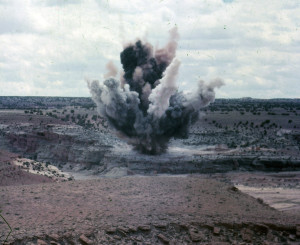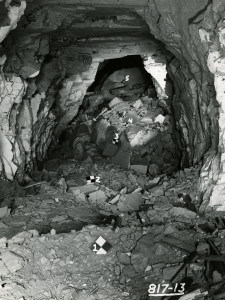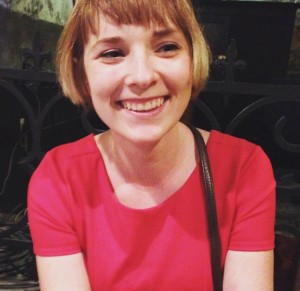Story
Delusions of a Wanna-Be History Detective
Winter Prather and the Underground Explosion Project
Having officially finished the Winter Prather collection (expect to see a finding aid online soon!), I have time to share one of the more obscure parts of Prather’s biography. First, just to recap: Winter Prather was a prominent commercial and fine art photographer working mostly in the Denver, Colorado and Taos, New Mexico from the 1940’s to the 1970’s. Thanks to the 2015 NHPRC Access to Historical Records grant that History Colorado received last May, I have been able to spend the last two months processing and cataloging Prather’s manuscripts and photographs.
It is an oft repeated misconception that Prather photographed atomic bomb testing. All evidence appears to back up this story. It is included in published materials about Prather. His former friends say he told anecdotes about it. There are even images of large explosions (see above) in the Winter Prather collection that are labeled “Underground Explosion Project” or “(U.E.P.)” Here’s the problem: these images are labeled with locations that say “Utah” or “Colorado,” and the only documented atomic blasts that occurred between 1951 and 1952 (when Prather allegedly shot the atomic bomb testing) took place at the infamous Nevada Test Site about 65 miles north of Las Vegas.
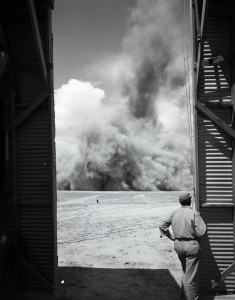
Unidentified worker watches large U.E.P. detonation from the safety of a barricade at an unidentified test site, c. 1951.
My first hunch about the images was logical; my second not so much. I initially assumed that in his older years, Prather had simply labeled his images incorrectly. Yet I kept finding images of detonations in sleeves with “Utah” or “Colorado” written on them. I then jumped to my second conclusion: OH MY GOD, I JUST UNCOVERED A GOVERNMENT CONSPIRACY!
I was pretty high on the idea that Prather had photographed some classified nuclear testing in Colorado and Utah, and that the U.S. Government had never owned up to it. Then I did some research. It turns out that I am not the only one with conspiracy theories about N-bomb testing in Utah. According in a 1995 article in the Deseret News, locals have believed for years that a nuclear bomb was detonated in 1951 at the Dugway Proving Grounds near Salt Lake City. However, Deseret News discovered via several FOIA requests that these explosions were not actually nuclear detonations, but TNT blasts produced by the U.E.P. According to the article, “The (once classified) documents reveal that nuclear scientists unleashed large, secret underground explosions at Dugway in May 1951 – and maybe at other times – with non-atomic conventional weapons to study effects expected from future underground atomic blasts in Nevada.” 1
This article poked a fair amount of holes in my conspiracy theory, but I was not yet ready to let go of my Agent Mulder mindset. I had only found one source that disproved my theory, afterall. So muttering “The truth is out there,” to myself, I set out to discover more about the U.E.P.
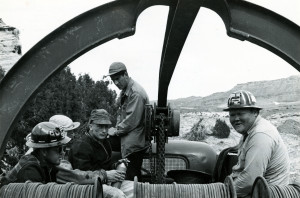
Unidentified workers in the back of a cable truck at an unidentified testing site, c. 1951.
I did not find too many references to the U.E.P. in academia. However, it was widely covered in local and national newspapers of the period. The most comprehensive report comes from a July 1952 edition of the Salt Lake City Tribune. Dubbing the U.E.P “Operation Protect-U,” the article’s author details how the U.S. Army Corps of Engineers and Engineering Research Associates (a private subcontractor) intermittently detonated various amounts of TNT to synthesize the physical consequences of atomic explosion from 1948 to 1952. Their aim, according to the article, was to discover which types of building materials and structures would provide the best protection in the event of an atomic blast. To accomplish this, U.E.P. technicians at the Dugway Proving Grounds in Utah detonated anywhere from 320 to 320,000 pounds of TNT in pits comprised of dry clay, wet clay, dry sand, and limestone. In 1951, the U.E.P. moved to Unaweep Canyon and Buckhorn Wash in Colorado to conduct similar tests with granite and sandstone. 2
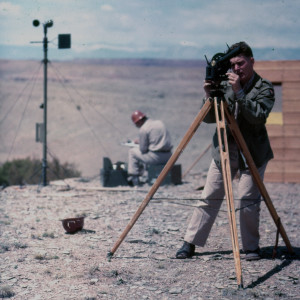
Fellow cameraman, identified as “Roland Flaterski,” looks through lens of camera, Dugway Proving Grounds, Utah, c. 1951.
So where does Prather fit into all of this? While the article does not mention him by name, it does state that various personnel of the University of Denver (where Prather worked and attended college) were subcontracted by Engineering Research Associates to photograph the testing. It is very likely that the photographs in the Winter Prather collection were taken during the U.E.P. tests.3 For Prather’s part, it seems that he enjoyed his stint with the U.E.P. He is reported to have written, “1951 was almost a vacation on U.S. Government checks.” 4
As if my conspiracy theory bubble wasn’t burst thoroughly enough, the article added further insult to injury. Not only were the U.E.P. tests not nuclear, they weren’t even secret! When the last of the U.E.P.’s TNT was detonated on July 8, 1952 at Buckhorn Wash, a crowd of hundreds including top military officials, renowned scientists, and various news outlets were there to watch! 5
-
Davidson, Lee (1995-04-08). “What Inspired Dugway N-Test Stories?Deseret News. Retrieved 2016-03-27.
-
Draper, Edna (1952-07-20). “Operation Protect-U.” The Salt Lake Tribune. Retrieved 2016-03-30.
-
Ibid.
-
Paglia, Michael. (2011). Foreward. Winter Prather: the Blink of an Eye. Denver, Colorado: Michael Horsley. pp 4-11.
- Ibid

